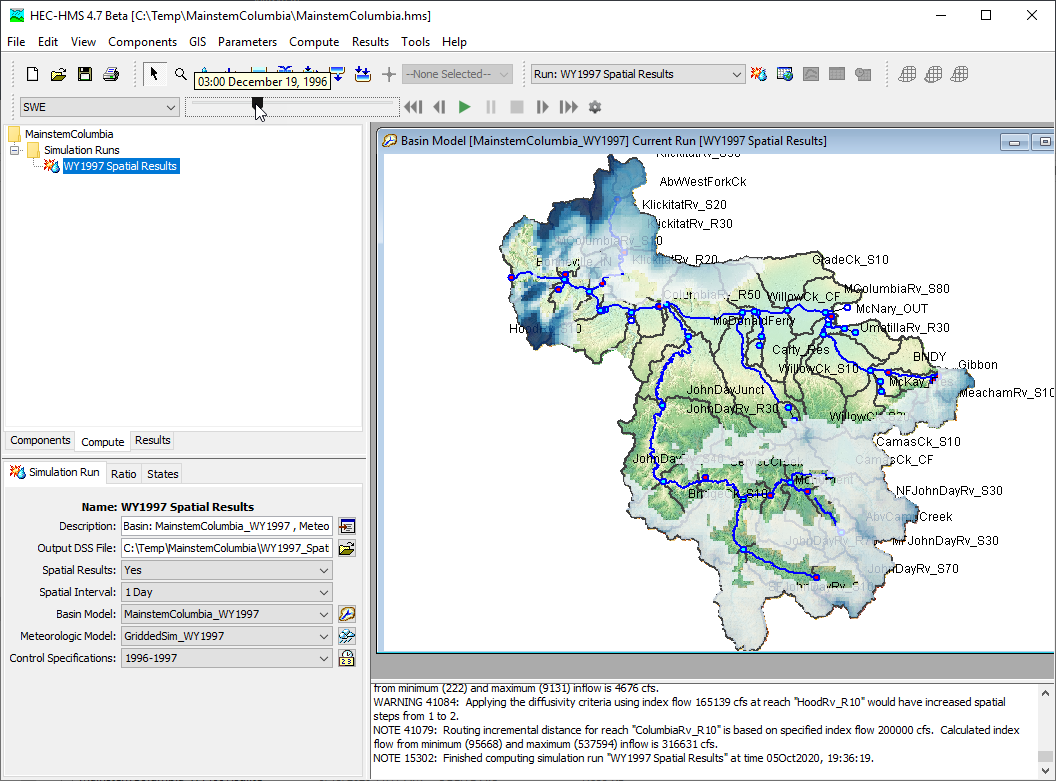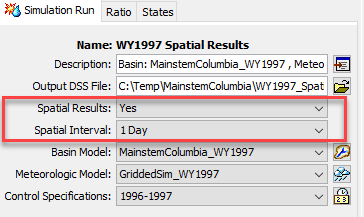Download PDF
Download page Viewing Spatial Results.
Viewing Spatial Results
The Spatial Results toolbar provides options to visualize results for basin models that have been created using GIS features (georeferenced elements). Spatial results must be turned on within the simulation run's Component Editor. Spatial results should be turned on after preliminary calibration has been completed. Use of spatial results can assist in the calibration process and provide additional information about the simulation. If you make edits to the basin geometry, edit model parameters, or change the simulation configuration, the spatial results will be automatically re-computed during the simulation.
The following figure shows the Spatial Results toolbar along with Snow Water Equivalent (SWE) results displayed on top of the basin model. The Spatial Results toolbar includes options for selecting output results, an animation toolbar, buttons for controlling the animation, and an Animation Setting button that opens an editor with options for color ramps, scale, animation speed, and whether the animation should loop.

Requirements for Spatial Results
A georeferenced basin model (subbasin elements must be georeferenced) is required to utilize spatial results. A georeferenced basin model can be created using the GIS tools to delineate elements from a terrain model. Another option to georeference a basin model is to use the Georeference Existing Elements or Import Georeferenced Elements tools from the GIS menu. These two tools use geographic information in shapefiles to georeference subbasin elements.
Spatial results can be visualized at the subbasin level, spatially averaged for the subbasin, or across the model domain using the discretization method chosen for the subbasin elements (structured discretization or unstructured discretization). Spatial results will be displayed at the grid or mesh level when the transform method is either ModClark or 2D Diffusion Wave and the structured, unstructured, and File-Specified *.sqlite, *.HDF5, and *.HDF discretization methods are selected. Gridded spatial results cannot be visualized for subbasin elements using the ModClark file option (under the File-Specified discretization method). Instead, results will be displayed as a subbasin average value when the *.mod file option is used for the File-Specified discretization method. Spatial results will be displayed at the subbasin level when transform methods other than the ModClark or 2D Diffusion Wave transform are used.
Activate Spatial Results
Spatial results can be displayed for both simulation runs and forecast alternatives. Spatial results must be activated in the simulation run's Component Editor, as shown below. You can also set the time interval for spatial results. The simulation time-step is used as the default interval. Spatial results are saved to an HDF5 file within the project's "results" directory; results are saved to an *.H5 file. Turning on spatial results will add additional time to the simulation due to additional output being generated and saved to disk. The additional time can be up to 1/3 of the simulation time without spatial results activated.
The very first time an output result is selected in the Spatial Results toolbar, the program will process the simulation HDF5 and build animation tiles for display. A message will pop up the very first time the output HDF file is processed indicating animation tiles are being created. The time it takes to build the animation tiles can be large for larger model domains; however, the processing is only required the very first time spatial results are displayed. The display time for subsequent simulations will be much quicker because animation information already exists.

Spatial Results Toolbar
As shown in the figure below, the Spatial Results toolbar is configured to 1) select an output result to visualize, 2) control the animation, and 3) edit the display and animation properties. Results that can be animated include meteorologic results, like incremental precipitation (INC_PRECIP), snow modeling results, and precipitation excess and loss. Flow depth and average cell velocity can be displayed for those subbasins using the 2D Diffusion Wave transform method. A full list of spatial variables is provided below:
- Albedo
- Antecedent Temperature-Index ATI
- Average Cell Velocity (2D Diffusion Wave transform only)
- Cold Content
- Cold Content ATI
- Cumulative Excess Precipitation
- Cumulative Loss
- Cumulative Precipitation
- Face Velocity (2D Diffusion Wave transform only)
- Flow Depth (2D Diffusion Wave transform only)
- Heat Deficit
- Hydraulic Depth (2D Diffusion Wave transform only)
- Incremental Excess Precipitation
- Incremental Loss
- Incremental Precipitation
- Liquid Water Content
- Melt Rate ATI
- Snow Pack Energy
- Snow Pack Temperature
- Sediment Concentration
- Snow Depth
- Surface Temperature
- Snow Water Equivalent
- Water Surface Elevation (2D Diffusion Wave transform only)
The animation can be controlled through the animation control slider bar and buttons. The slider bar can be manually dragged right or left to advance or reverse results. The animation control buttons include a button to go to the beginning of the animation, move forward one time interval, pause the animation, reverse the animation one time interval, and go to the end of the animation.

The figure below shows the Animation Settings editor. The Select Color Ramp and Scale button will open another editor that includes options for the color ramp and scale used to display the selected results. The Minimum Value and Maximum Value options will be active based on the Scales selection made in the Color Ramp and Scale Editor. The frame rate controls the speed of the animation. Check the Loop Animation check box to automatically have the animation start over when it reaches the end of the time window. The Apply button must be pressed after edits are made to the Animation Settings, then press the Close button to close the editor. The program contains default color ramps and scales for each output type. You can customize the color ramp and scale settings and the program will save the customized information for each simulation-variable combination.

The following figure shows the Color Ramp and Scale Editor. There are default color ramps and scales to select from, and these cannot be modified. Additional color ramps and scales can be created using the New or the Copy button in the appropriate panel. The Rename and Delete buttons can be used to manage user created color ramps and scales. For either default or user defined color ramps, options are available for defining the transparency percent, inverting the color ramp, and applying hillshading. The option to define out of range colors will be active only for user defined color ramps. When creating a new color ramp, colors are selected by double clicking on the color boxes at the bottom of the editor. User defined scales allow for the selection or modification of the values on the scale. Additional options for user defined scales include the scale reference, scale type, and scale units.
The Apply button must be pressed after edits are made to the Animation Settings, then press the Close button to close the editor.
